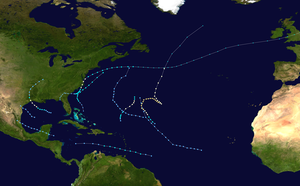| 1986 Atlantic hurricane season | |
|---|---|
 Season summary map | |
| Seasonal boundaries | |
| First system formed | June 5, 1986 |
| Last system dissipated | November 21, 1986 |
| Strongest storm | |
| Name | Earl |
| • Maximum winds | 105 mph (165 km/h) (1-minute sustained) |
| • Lowest pressure | 979 mbar (hPa; 28.91 inHg) |
| Seasonal statistics | |
| Total depressions | 10 |
| Total storms | 6 |
| Hurricanes | 4 |
| Major hurricanes (Cat. 3+) | 0 |
| Total fatalities | 21 total |
| Total damage | > $67.5 million (1986 USD) |
| Related articles | |
The 1986 Atlantic hurricane season was a very inactive season that produced 10 depressions, 6 named storms, 4 hurricanes, and no major hurricanes. The season officially began on June 1, 1986, and lasted until November 30, 1986. These dates conventionally delimit the period of each year when most tropical cyclones form in the Atlantic basin. During the 1986 season, the first subtropical depression formed in the first week of June, while the last tropical cyclone dissipated at the end of the third week of November. The 1986 season had lower than average activity because of an ongoing El Niño event, and was the least active season in the North Atlantic since the 1983 Atlantic hurricane season. This was also the first season since 1972 to have no major hurricanes.[1]
The season started on June 5 when Subtropical Depression One formed near the Bahamas, which would later gain tropical characteristics and become the first tropical storm of the season; Tropical Storm Andrew. On June 9, Andrew would later be absorbed by a larger low pressure system. On June 23, the season's first hurricane formed; Bonnie, although it attained hurricane status on June 25, just two days after Bonnie's formation. Two more tropical depressions followed suit later in the season. On August 13, the season's fifth tropical depression formed and would later become Hurricane Charley four days later. After Charley dissipated, two more tropical depressions formed on August 31 and September 1. Both dissipated on September 4. On September 7, Tropical Storm Danielle formed and would dissipate on September 10. Just after Danielle dissipated, Hurricane Earl formed and would later become the strongest system of the 1986 Atlantic hurricane season, peaking as a 105 mph Category 2 hurricane and 979 mbars in lowest pressure. No tropical cyclones formed during the months of October and the first half of November. That is, until Hurricane Frances became the latest sixth named storm on record since tropical cyclones were first named in 1950. The season came to a close on November 21, which was when Frances dissipated.